If you ever find yourself in Emilia-Romagna, Ravenna is an absolute must. It really is a treasure trove of art and culture, writes Sara Scarpa.
Above me is depicted a dark blue sky full of golden stars.The many thousands of tiny mosaic tiles set in various inclinations seem to capture and cascade light onto anyone looking up at them from below.
Concentric circles glow, and the shimmering movement of light seems to follow me as I move around the room. This mesmerising place is small and dark, although the narrow alabaster stone windows do filter through a soft, golden light that adds to the ethereal feeling of the place.
In the middle of this vibrant starred sky stands a huge, golden Latin cross, and at the corners of the dome are the four winged creatures that symbolise the Four Evangelists – the Man (Matthew), the Lion (Mark), the Ox (Luke) and the Eagle (John).
Within the lunette, a male figure, thought to be St Lawrence – the 3rd-century deacon of Rome who died a martyr’s death in flames – is holding a cross and a book and is appearing to transcend towards a grid of fire. On the opposite side, there is a cabinet containing four books labelled with the names of the Evangelists, the Four Gospels. In another lunette, Christ as the Good Shepherd is tending his flock.
Deer and doves drinking from a fountain and plants and flowers complete this wonderful work of art made of minuscule tesserae which shimmer with beauty. The atmosphere is really quite magical. It comes as no surprise to realise that this was the place that struck the poet D’Annunzio and that inspired Cole Porter to write his famous song Night and Day.
Art lovers must have already guessed that the place I am describing is the interior of the Mausoleum of Galla Placidia, the final resting place of the daughter of Roman Emperor Theodosius I, the wife of the Emperor Constantius III, and a Roman Empress in her own right.
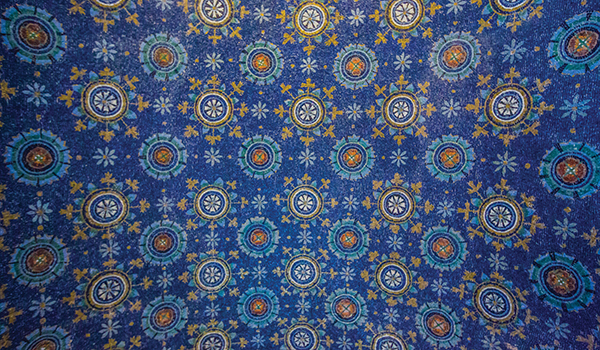
And this is only the first of many jewels you can admire in the remarkable city of Ravenna.
Though it is a relatively small town, with a population of just under 12,000 people, Ravenna affords the visitor the opportunity to take in no fewer than eight sites included in the UNESCO World Heritage list.
Ancient city
This ancient city on the Adriatic Sea was, fifteen hundred years ago, the last capital of the Western Roman Empire. Then it became the capital of a Barbarian kingdom in Italy, and later still it became a city of great importance for the Byzantine conquest under Justinian. The splendour of that period can be seen in the collection of stunning mosaics, dating back to the 5th and 6th centuries, which is one of the richest and best preserved in the world. It is astonishing to think that they are more than one and a half thousand years old and yet they still shimmer as they used to!
Besides the Mausoleum of Galla Placidia there are seven more sites on the UNESCO World Heritage list for you to see here: the Basilica di San Vitale; the Arian Baptistery; the Baptistery of Neon; the Basilica of Sant’Apollinare Nuovo; the Basilica of Sant’Apollinare in Classe; the Oratory of Sant’Andrea (also known as the Archiepiscopal Chapel); and the Mausoleum of Theoderic. All of them – with the exception of the Basilica di Sant’Apollinare in Classe, which is located eight kilometres from the centre – are within easy walking distance of each other.
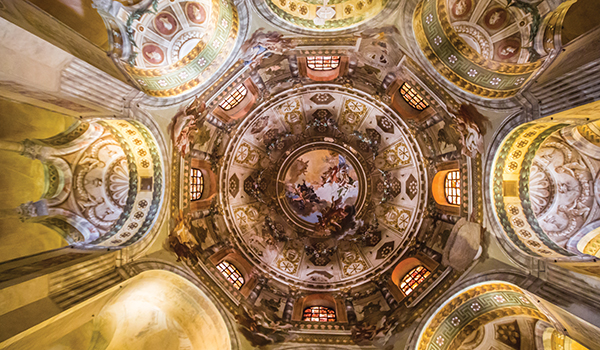
Don’t be put off visiting them all by any notion that each location will be the same as the last. Each site is unique. You can view them with or without a guided tour, though the tours are all reasonably priced. Throw in some stunning frescos, the final resting place of the poet Dante, and the city’s many culinary delights, and you will soon realise that Ravenna truly is a hidden gem.
Real charm
The real charm of Ravenna is found in the combination of the mosaics with the city itself. Ravenna is tranquil, elegant and away from the crowds of tourists, with an intimate atmosphere. Within its pedestrian-zoned historic centre, Ravenna has pretty cobblestone streets, nice squares, lovely boutique shops, traditional restaurants, osterie brimming with people, and plenty of public gardens and parks.
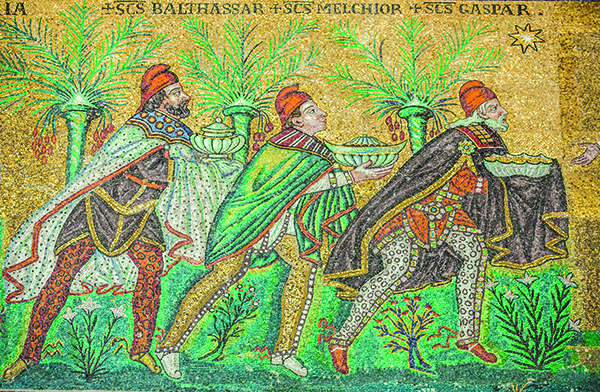
If you are walking or cycling in the city centre you will easily find the main square, Piazza del Popolo. Built by the Venetians when Ravenna was under the dominion of La Serenissima, this elegant square is the real heart of the city. Not far from Piazza del Popolo, don’t miss the Basilica di San Francesco with his ancient crypt – its floor is permanently covered with water (small fish swim in it!) but you can still glimpse fragments of the mosaics floor of the original church.
If you do wish to take a small break from the mosaic art then don’t forget to visit to tomb of Italy’s finest medieval poet, Durante degli Alighieri, or, as the world generally refers to him, Dante. The great Florentine poet was in exile in Ravenna when he died (in 1321) and in spite of Florence’s attempts for his body to be returned to his birthplace, his remains still rest here in Ravenna in a small mausoleum.
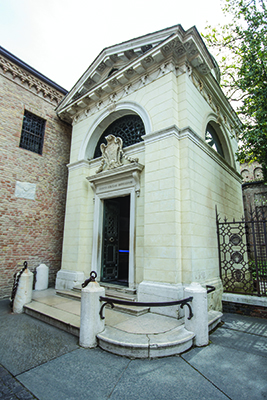
On the anniversary of his death every year the City of Florence sends olive oil to burn perennially in the votive lamp hanging in the mausoleum as an act of penance for expelling the poet in 1372. Modest but elegant, the small building has a bas-relief by Pietro Lombardo representing the great poet reading and thinking.
In the Basilica di San Vitale, the most-visited of Ravenna’s UNESCO World Heritage sites, you will meet another very powerful woman, Theodora. Taking up a large space at the foot of the apse side wall, a stunning mosaic portrays the Empress Theodora with her courtiers. She is tall, bejewelled, wearing a crown and a royal purple silk robe with the Three Magi embroidered at the hem. She has a golden halo to emphasise the fact that her power originates in the divine. On the opposite wall, her husband, the Emperor Justinian, seems to look at her in admiration.
Theodora was one of the most influential women of the ancient world and the Emperor’s most trusted advisor. She was an actress, a prostitute, a spy, an early feminist and an empress. She worked for women’s marriage and dowry rights, anti-rape legislation and she had laws passed which prohibited the trafficking of young girls. Theodora and Justinian are represented here on the walls of the Basilica to show the world that they are back in charge and are recapturing the glories of the Roman Empire. (Theodora: Actress, Empress, Whore by Stella Duffy is a great read.)
The Basilica di San Vitale is a mix of styles: octagonal Roman floor plan, Byzantine architecture and Baroque frescoes. It represents the transition from the classical to the Byzantine style.
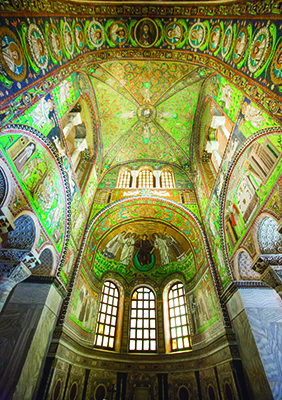
Just outside the city, the Mausoleum of Theoderic is a unique architectonic event. Commissioned by Theoderic himself, it was built by large blocks of stone and resting on the top there is a single stone block weighing over three hundred tonnes, probably one of the largest in the world. According to legend, Theoderic had this mausoleum built to escape a prophecy that said he would die hit by a lightning bolt. Unfortunately, in spite of the solid construction, they say that this is exactly what happened inside…
Five kilometres from the centre of the city you will find the Basilica di Sant’Apollinare in Classe. This is one of the most important surviving examples of a Byzantine monument in Italy, and is well worth the trip out of town to see it.
Culinary specialities
Beyond the eight UNESCO World Heritage sites and the many other artistic and architectural treasures, Ravenna also offers great culinary specialities. Cappelletti (filled pasta shaped like ‘little caps’), maltagliati (the irregular-shaped, ‘badly-cut’ pasta typical of Emilia-Romagna) passatelli (a pasta made with bread crumbs) and spoja lorda (square-shaped pasta parcels often filled with the leftovers from cappelletti), are some of the typical pasta courses.
These can be followed by castrato di Romagna (mutton) or mora romagnola (pork) with a side dish of asparagus and squacquerone cheese, a Romagna variety with DOP status, all washed down with a glass of Sangiovese, Trebbiano or Pagadebit. A typical dessert is the Theodora cake, inspired by the famous Empress we have talked about.
Do not forget to try the piadina and the crescione di Romagna. The piadina, as you probably already know, is a thin Italian flatbread usually eaten with prosciutto, squacquerone and rocket. The crescione is a large, stuffed ravioli-like bread prepared with the same ingredients as piadina and are usually filled with pumpkin and potatoes, mozzarella and tomato, spinach and herbs.
If you are here for more than a couple of days you should definitely explore Ravenna’s surroundings as wells. There is a great variety of landscapes around the city, ranging from farmlands, marshes and canals to pinewoods and beaches. Seaside resorts stretch along its 30km coastline offering sunbathing, sport and fitness. For nature lovers the surroundings of Ravenna offer one of the largest green areas in northern Italy: the Oasis of Punte Alberete, whose forests shelter a number of rare species of birds, and the ancient pinewoods of San Vitale in Classe are within the nature reserve of the Po Delta Park. Do visit the NatuRa Museum of Sant’Alberto too.
As you can see there is so much to see and try in this small city that it definitely deserves more than just a day trip to enjoy it fully!
